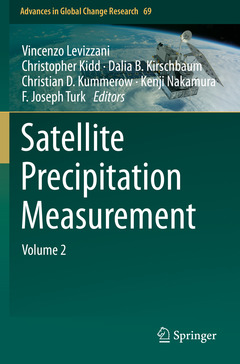Description
Satellite Precipitation Measurement, 1st ed. 2020
Volume 2
Advances in Global Change Research Series, Vol. 69
Coordinators: Levizzani Vincenzo, Kidd Christopher, Kirschbaum Dalia B., Kummerow Christian D., Nakamura Kenji, Turk F. Joseph
Language: English
Subjects for Satellite Precipitation Measurement:
Keywords
Satellite meteorology; Precipitation: rainfall and snow measurements; Climate and water cycle; Tropical Rainfall Measuring Mission; Observations and retrieval techniques; Measuring precipitation from Space; International Precipitation Working Group; Precipitation data; meteorology; climate change impacts
Publication date: 04-2021
Support: Print on demand
Publication date: 04-2020
725 p. · 15.5x23.5 cm · Hardback
Description
/li>Contents
/li>Biography
/li>Comment
/li>
This book offers a complete overview of the measurement of precipitation from space, which has made considerable advancements during the last two decades. This is mainly due to the Tropical Rainfall Measuring Mission (TRMM), the Global Precipitation Measurement (GPM) mission, CloudSat and a carefully maintained constellation of satellites hosting passive microwave sensors. The book revisits a previous book, Measuring Precipitation from Space, edited by V. Levizzani, P. Bauer and F. J. Turk, published with Springer in 2007. The current content has been completely renewed to incorporate the advancements of science and technology in the field since then. This book provides unique contributions from field experts and from the International Precipitation Working Group (IPWG).
The book will be of interest to meteorologists, hydrologists, climatologists, water management authorities, students at various levels and many other parties interested in making use of satellite precipitation data sets.
Christopher Kidd obtained a BSc in Geography from the University of Nottingham,followed by a PhD from the University of Bristol. He has been at the forefront of satellite precipitation estimation over the last 30 years, focusing upon retrieval schemes from both passive microwave observations and multi-sensor observations, together with the verification, validation and inter-comparison of satellite estimates and surface measurements.
Dalia B. Kirschbaum is a Research Physical Scientist in the Hydrological Sciences Lab at NASA Goddard Space Flight Center in Greenbelt, Maryland. She has served as the Global Precipitation Measurement (GPM) Mission Associate Deputy Project Scientist for Applications since 2009, where she leads a team of outreach and applications specialists to provide scientific support for applications research and activities. Her research interests center on the application of GPM data to rainfall-triggered landslide modeling efforts, including a global landslide situational awareness system that is being used




